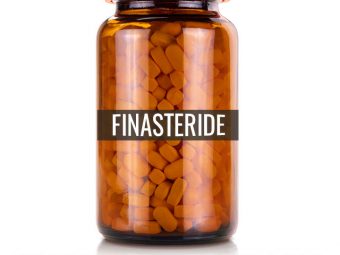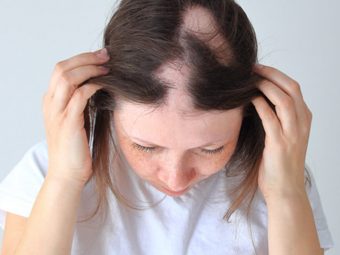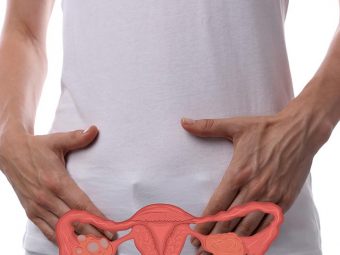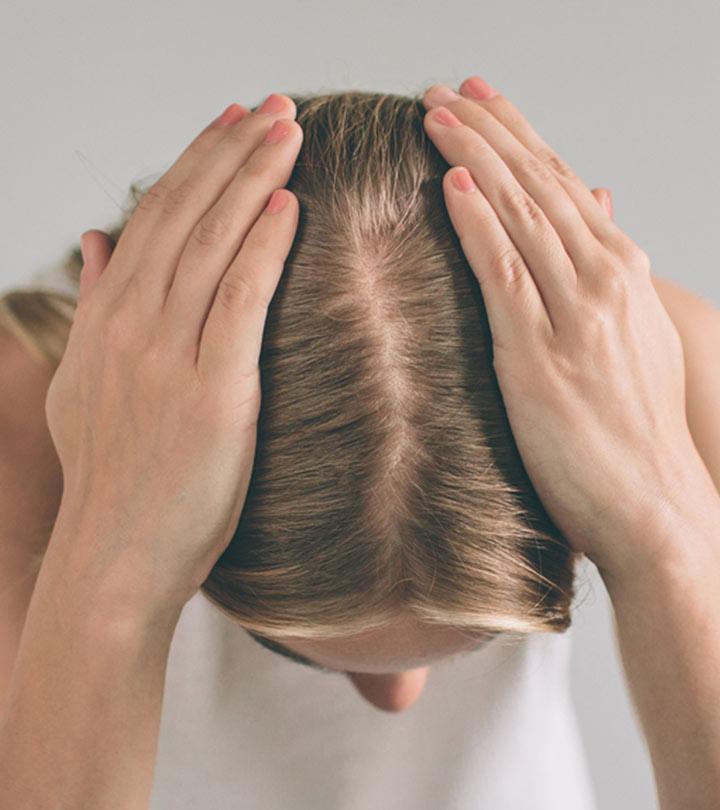Spironolactone For Hair Loss: Dosage And Side Effects
Now matter how good it could be, it is important to be aware of its complications too.

Image: ShutterStock
Most women experience hair loss and thinning in their post-menopausei XA permanent stage of life characterized by the lack of menstruation and lowered levels of female sex hormones. period. While this may have many underlying reasons, one specific solution seems effective. The use of spironolactone for hair loss is gaining popularity (1). This FDA-approved anti-androgen drug is used to treat fluid retention, kidney diseases, high blood pressure, and liver diseases.
It also can minimize the production of adrenal androgen and reduce androgenetic alopecia (female pattern baldness).
 Know Your Ingredient: Spironolactone
Know Your Ingredient: SpironolactoneWhat Is It?
A prescribed medication primarily used to treat fluid retention and hair loss.
What Are Its Benefits?
It may slow down the development of androgenic alopecia and encourage hair regrowth.
Who Can Use It?
It can be taken by anyone, but you should talk to your healthcare provider to make sure it is the right choice for you.
How Often?
It can be taken every day, although the dosage may depend from person to person.
Caution
Excess consumption can cause headaches, weight loss, increased urination, fatigue, dry skin, nausea, irregular periods, diarrhea, and breathing issues.
This article explores how the aldosterone antagonist, spironolactone works for hair loss, how to use it, and certain possible side effects you must be aware of. Continue reading.
In This Article
What Is Spironolactone?
Spironolactone is an anti-androgen, diuretic drug. It was mainly used for treating hypertensioni XHigh blood pressure characterized by a reading of 140/90 or higher, which suggests the blood is pushing too hard against the arterial walls. , symptoms of polycystic ovary syndrome (PCOS) and hirsutismi XA condition characterized by excessive androgen levels that cause unwanted male-pattern hair growth on a woman's face, front, and back. . However, spironolactone prevents adrenal androgen production in the body and thus, minimizes PCOS hair loss or androgenetic alopecia (1). Besides treating female pattern hair loss (FPHL), the androgen receptor blocker may also be beneficial in reducing hirsutism and acne. The section below delves further into how this potassium-sparing diuretic works to prevent hair thinning and hair loss.
How Does Spironolactone Work?

Spironolactone slows down androgen production. Androgens are a group of male sex hormones, including testosterone. In females with PCOS and hormonal imbalance, excess production of androgens may cause hair loss. A study found that the daily consumption of spironolactone in the prescribed dosage can reduce hair loss and increase the number of hair follicles in the anagen phase (1).
Amy, a blogger, takes Spironolactone for androgenic alopecia due to PCOS and reveals on her blog: “You will need a prescription for 100 mg 2x a day from your doctor. You also periodically need to get [your] potassium levels checked while you are taking this drug. This is the only prescription drug that I take to help my PCOS (i).”
The dosage of spironolactone depends on the purpose it is being used for.
 Did You Know?
Did You Know?How Much Of Spironolactone Is Prescribed For Hair Loss?

A study found that a dose of 200 mg of oral spironolactone effectively improved female pattern hair loss (1). Doctors generally prescribe a dosage between 50-200mg of spironolactone for hair loss. However, the dosage may vary, depending on the severity of your hair loss. The doctor may even prescribe a combination of drugs to be taken with spironolactone, such as (1):
- Spironolactone With Oral Contraceptive: This combination is often used to prevent menstrual irregularities and improve female pattern baldness and acne.
- Spironolactone With Minoxidil: A 2% topical minoxidil solution improves hair growth rate and hair thickness by lengthening the anagen (growth) phase and shortening the telogen (hair fall) phase of the hair (3).
Your doctor may also prescribe topical spironolactone for treating hair loss.
Spironolactone: Topical Or Oral?
You may take spironolactone orally or apply a topical solution.
Topical treatment is preferred as it cuts down many possible side effects of oral spironolactone. Research found that 5% spironolactone gel can promote hair growth and is a good option for managing androgenic alopecia (4).
The doctor will evaluate the severity of your hair loss and other complications caused by polycystic ovary syndrome (PCOS) and then prescribe either topical or oral spironolactone. Once you start taking it, you may expect results in a few months. However, the duration may vary from person to person.
 Did You Know?
Did You Know?How Long Does It Take For Spironolactone To Work?

Do not expect overnight results. Spironolactone may take at least six months to show results. However, it may vary, depending on the severity of the condition. You may even notice changes after a year of using the drug.
You have to follow up with your doctor after taking the androgen receptor blocker, spironolactone for six months. They may even increase the dosage, depending on the results, or suggest a combination of medications.
Spironolactone is not prescribed for everyone. Find out next who can use the drug and who should avoid it.
Who Can Use Spironolactone For Hair Loss?
Spironolactone is mainly prescribed for women with androgenetic alopecia or female pattern hair loss. However, avoid spironolactone if you (5):
- Have kidney-related issues
- Have high blood potassium levels
- Have Addison’s diseasei XA chronic condition wherein your adrenal glands fail to produce adequate cortisol and aldosterone hormones.
- Are taking eplerenone (steroid)
- Are pregnant or nursing
Teenagers below 18 years of age should also avoid this drug. If taken in the wrong way, spironolactone may have some health risks.
What Are The Side Effects Of Spironolactone?
As spironolactone is commonly prescribed for hypertension, some people may experience low blood pressure while using this drug. This is why it is crucial to take it in the prescribed dosage. Otherwise, it may cause issues like (6):
- Headache
- Weight loss
- Fatigue
- Increased urination
- Dry skin
- Decreased libido
- Drowsiness and nausea
- Irregular periods
- Diarrhea
- Depression
- Breast tenderness
Overdose of spironolactone may also cause:
- Breathing problems
- Rashes
- Dizziness
- High potassium levels
High potassium levels can be life-threatening. Visit a doctor immediately if you experience:
- Weakness
- Muscle fatigue
- Abnormal heart rate
- Paralysis
Infographic: Must-Know Facts About Spironolactone
Hair fall is a common condition experienced by a lot of people around the world. We try different methods and techniques to reduce hair loss and promote hair growth. Spironolactone is one such drug that may help you maintain your hair health. However, you must adhere to certain dos and don’ts to avoid unnecessary complications. The infographic below highlights the major things you need to know before using this drug. Check it out.

Illustration: StyleCraze Design Team
Spironolactone can help minimize hair loss caused by androgenic alopecia. The doctor may prescribe oral or topical spironolactone and combine it with other medications to treat hair loss. If you consider taking spironolactone for hair loss, remember that you will not see overnight results. It may take time, and you must diligently follow the treatment. Consult with your doctor to determine whether this medication is suitable for treating your condition and the right dosage. Also, inform the doctor about your underlying health issues before starting the treatment and report the progress and changes you may notice.
Frequently Asked Questions
Which is better for hair loss, finasteride or spironolactone?
While both finasteride and spironolactone are effective for treating hair loss, spironolactone has fewer side effects (4).
Is it better to take spironolactone in the morning or at night?
You should take spironolactone as per your doctor’s advice. Ensure that you take the medication at the same time daily.
Key Takeaways
- You can treat PCOS hair loss or androgenetic alopecia by using spironolactone.
- It stops the production of adrenal androgen, which is the major cause of androgenetic alopecia.
- It can be applied topically or even can be taken orally if prescribed.
- However, side effects like dry skin, hair loss, and headaches are also seen in a few sensitive individuals.

Image: Stable Diffusion/StyleCraze Design Team
Learn about the effects of spironolactone on the kidneys and female pattern hair loss and discover a more reliable treatment. Get the facts in the video below and make an informed decision.
Personal Experience: Source
StyleCraze's articles are interwoven with authentic personal narratives that provide depth and resonance to our content. Below are the sources of the personal accounts referenced in this article.
i. PCOS AND HAIR LOSS – What Works for Mehttps://divapcos.wordpress.com/2010/11/14/pcos-and-hairloss-what-works-for-me/
References
Articles on StyleCraze are backed by verified information from peer-reviewed and academic research papers, reputed organizations, research institutions, and medical associations to ensure accuracy and relevance. Read our editorial policy to learn more.
- Female Pattern Alopecia: Current Perspectives.
https://www.ncbi.nlm.nih.gov/pmc/articles/PMC3769411/ - Incidence of female androgenetic alopecia (female pattern alopecia)
https://pubmed.ncbi.nlm.nih.gov/11231244/ - Minoxidil and its use in hair disorders: a review
https://www.ncbi.nlm.nih.gov/pmc/articles/PMC6691938/ - Topical Finasteride versus Topical Spironolactone in the Treatment of Androgenetic Alopecia
https://mjcu.journals.ekb.eg/article_110836_e38786e7057303e85115bcb620bdc96b.pdf - Oral Spironolactone in Post-teenage Female Patients with Acne Vulgaris
https://www.ncbi.nlm.nih.gov/pmc/articles/PMC3315877/ - Female pattern hair loss: Current treatment concepts
https://www.ncbi.nlm.nih.gov/pmc/articles/PMC2684510/





























